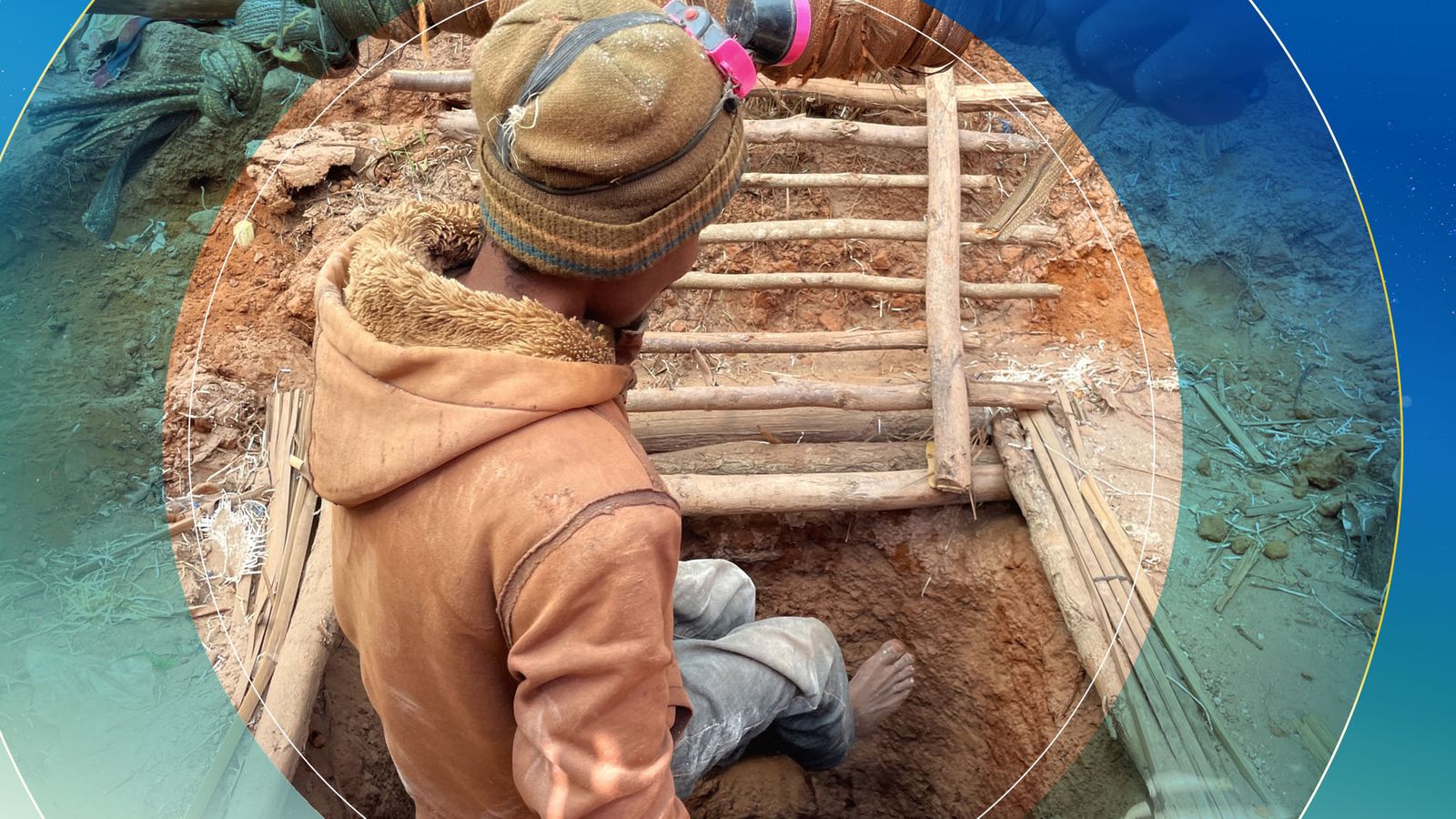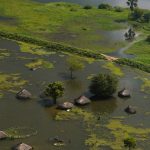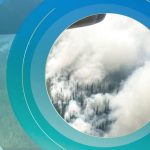The mountainside towering above Madagascar’s biggest freshwater lake in the island’s northern central plateau is a mass of pitched tents – pockmarked with manmade mining shafts.
It’s like the whole area has been turned inside out.
The forest that once covered this huge spread of land in the Alaotra-Mangoro region has long gone, probably never to return.
In its place are hundreds and hundreds of mounds of dead grey soil and rubble on the edges of dark, dangerous shafts, down which thousands risk their lives every day.
And Madagascar is paying for this in a currency called climate change.
At least two of our Sky News team independently described the scene as reminiscent of a World War Two battlefield out of the history books.
It is bleak, grey and monotone – and there are ramparts, ditches, trenches and sandbags all around.
COP26: Hunger pangs drown out fear of jail as climate crisis sees many Madagascans turn to poaching
Madagascar is on the brink of famine caused by climate change, with children most at risk
‘A wake up call’: Madagascar teeters towards world’s first climate change induced famine
Please use Chrome browser for a more accessible video player
In a way, they’re right. This is a war.
It’s a war by man (and they are invariably men) on the Earth itself – and the Earth is losing.
Everywhere we look around this makeshift and extensive mining encampment, at the edge of Lake Alaotra, we see activity.
It is a mountain of dreams.
Dreams which tunnel deep into the earth, sometimes more than 70m (230ft) beneath the surface. Dreams of riches. Dreams of an end to the abject poverty the bulk of the country’s population is enduring. Dreams of finding that precious gem which will transform their lives and take them away from all of this.
This is what they daily gamble with their lives for – the possibility of chipping out a gem that will make them millions.
“I came here to make money,” Ali tells us. “I want to change my life. I’ve been working down mines since I was 12 years old.”
He’s now 37.
“It’s what I know. It’s the only job I can do,” he says.
“I found an amethyst stone once on a different site which meant I could get married,” he continues, “And I got a beryl gem here on this site in March and sold it for two million ariary [£375].”
Please use Chrome browser for a more accessible video player
Since then, he’s found nothing.
Yet seven months later, every day he’s still rolling the dice on life and death, lowering himself down with his friends, barefoot and balanced on a wooden stick attached to a frayed rope, on a pulley system they’ve built themselves.
They descend one by one into a jet-black crumbling shaft and crawl on their hands and knees along a dog-leg horizontal tunnel that is barely big enough to take them with nothing but a head torch.
Air is pumped down to them through a flimsy plastic tube which drops down into the shaft and is attached to an equally inadequate bigger bag on the surface which one of the team squeezes fairly regularly.
“Sometimes if it’s not windy enough up here we struggle to fill the bag with air,” Lux explains. He’s doing the most important job on the surface.
One end of the bag has an opening and Lux rhythmically traps air inside it, closes the entrance around his hands and then presses down using his elbow to push the air along the long transparent tube dangling over the edge and into the shaft.
We watched aghast as minutes after Ali is lowered into the tunnel, the bag rips open.
“For sure by now he will be struggling to breathe,” one of Ali’s crew mentions almost casually. It seems to be a fairly regular occurrence.
They tell us the men frequently pass out as their air supply is interrupted.
On the surface, three of his crew patch together the vital air bag with strips of sticky tape. And work continues. They spend up to six hours down there.
These are desperate people taking desperate measures to make a living – but their dreams of a fortune are adding to an environmental nightmare which is destroying the country’s habitat and which scientists believe is exacerbating climate change and extreme weather patterns.
Madagascar seems to have gotten itself into a vicious cycle of misery.
The United Nations has said the country is on the brink of suffering the world’s first famine caused by climate change – which has seen crops fail and rivers dry up followed by widespread hunger and starvation.
The dire situation has heightened the desperation felt by people who were already incredibly poor and turning to anything just to survive.
So, more engage in illegal mining; more cut down trees to sell or make coal; more deforestation creates more climate change and yet more difficult conditions so yet more turn to illegal mining and cut down trees and so it goes on and on.
On top of this, there is intense criticism about just what role successive governments have played in this.
Poor governance, lack of governance, corrupt governance and political instability have all been pinpointed as contributory factors by critics and cannot be discounted.
Please use Chrome browser for a more accessible video player
But Madagascar is not at war and the president, Andry Rajoelina, believes the impact of huge carbon emissions created by actions in rich countries far away is directly impacting his poor country the most.
“My compatriots are bearing the brunt of a climate crisis which is not of their own making,” he told the conference in Glasgow.
Madagascar emits 0.01% of global carbon emissions.
But this pitifully poor country, where only 15% have electricity, has engaged in mass deforestation to provide firewood to burn as fuel; to make coal that can provide much needed cash – and to make way for mining which is viewed as a potential pathway to riches.
“I plead for an energy transition that protects our forests by financing alternatives to coal on the continent,” President Rajoelina tweeted from COP26.
He was amongst the host of nations which signed the accord to stop deforestation by 2030, proudly “reaffirming Madagascar’s commitment to the fight against deforestation especially in Africa”.
UK government officials indeed had meetings with him and vowed to become more involved in supporting the emergency in the country’s Grand Sud, where starvation and hunger is most acute.
The country’s minister for environment and sustainable development, Vahinala Raharinirina, was less diplomatic than her president when interviewed by the Guardian newspaper at COP26, blaming the rich industrialised nations for letting down the poor global south by failing to follow through on funding promised at the previous climate conference in Paris.
She said a pipeline which would help transport much-needed water from the north to the drought-stricken south would cost $9m – a pittance to rich countries but too costly for Madagascar.
“It’s not aid,” the newspaper quoted her as saying, “It’s accountability.”
But it’s difficult to see what’s being actively done on the ground in Madagascar to stop this deforestation blamed for contributing to the climate crisis – and which is driven by poverty and hunger.
There are an estimated 6,000 illegal miners on the site we visit, predominantly men, engaged in activity around shafts which have been hammered out by hand and from which they have hopes of carving out precious beryl.
Beryl is from a gem family which encompasses some of the world’s most popular and expensive precious stones, such as emerald and aquamarine.
This is just one mining community.
There are many, many more across Madagascar, hidden in forests as well.
Illegal mining is estimated to be the island’s second-largest industry after agriculture.
The World Bank has estimated the illegal gem smuggling racket is more than a hundred million dollars a year – at least.
The world’s fourth-largest island has an underground jam-packed with almost as many treasures as it enjoys on the surface.
Alongside beryl, it has rubies, sapphires, gold, quartz, amethyst and graphite.
There seems to be no end to Madagascar’s natural riches. Yet it remains one of the poorest countries in the world.
The miners and the loggers we speak to, all tell us about few alternatives and little choice.
Lux tells us: “If they stop us mining here, we will just move to another site and continue there. This is our only way of making a living.”
We see Robert chopping down eucalyptus trees on a hillside a few hours drive away from the mining site – and he makes similar comments.
The trees are being felled at an astonishing rate.
Robert admits he’s already brought down about 50 in the few hours he’s been on the hillside and expects to finish his working day having chopped down about a hundred trees.
He’s in a team of 10 and the area they’re working their way through already has large empty patches of cleared forest.
He insists he has “permission”, understands the environmental implications but defiantly protests to us: “It’s the only way I can make some money.”
But the clearing of trees and widespread deforestation and soil erosion for whatever reason – for selling, for charcoal, to make way for these mostly unregulated mines – has dangerously exposed a nation already most vulnerable to climate change and weather extremes.
And that in turn is threatening its abundance of unique wildlife and plants, many of which are only found on this island.
Subscribe to ClimateCast on Spotify, Apple Podcasts, or Spreaker
For full coverage of COP26, watch Climate Live on Sky channel 525.
Follow live coverage on web and app with our dedicated live blog.
Get all the latest stories, special reports and in-depth analysis at skynews.com/cop26






















